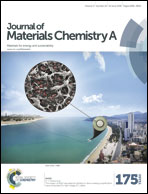3D ultralong nanowire arrays with a tailored hydrogen titanate phase as binder-free anodes for Li-ion capacitors†
Abstract
Well-ordered, self-supported ultralong nanowire arrays (NWAs) with a 3D structure and tailored hydrogen titanate (HTO) phase have been synthesized via a facile template-free hydrothermal method and subsequent calcination and utilized as anodes in Li-ion capacitors (LICs) directly without any ancillary materials. The 3D structure constructed from ultralong nanowires and a rooftop network is beneficial to structural stability, electrolyte penetration, rich electro-active sites and short Li-ion transport paths. Moreover, the tailored HTO phase can introduce stronger and more effective Li-ion diffusion channels for the fast Li-ion insertion/extraction reaction. These merits from morphological and crystal structural design yield superior electrochemical performance in terms of high capacity, excellent rate capability and ultralong lifespan. The LIC assembled with a HTO NWA anode and activated carbon (AC) cathode achieves an attractive energy storage of 93.8 W h kg−1 and a capacitance retention of 78.8% after 3000 cycles at a high current density of 5.0 A g−1 within 0.0–3.0 V. Even at a rapid charging rate within 8.0 s, an excellent energy density of 33.3 W h kg−1 and a high power density of 15 kW kg−1 can be retained. Therefore, the HTO NWAs//AC LIC is a promising candidate as an energy storage system for high-energy and high-power applications.



 Please wait while we load your content...
Please wait while we load your content...